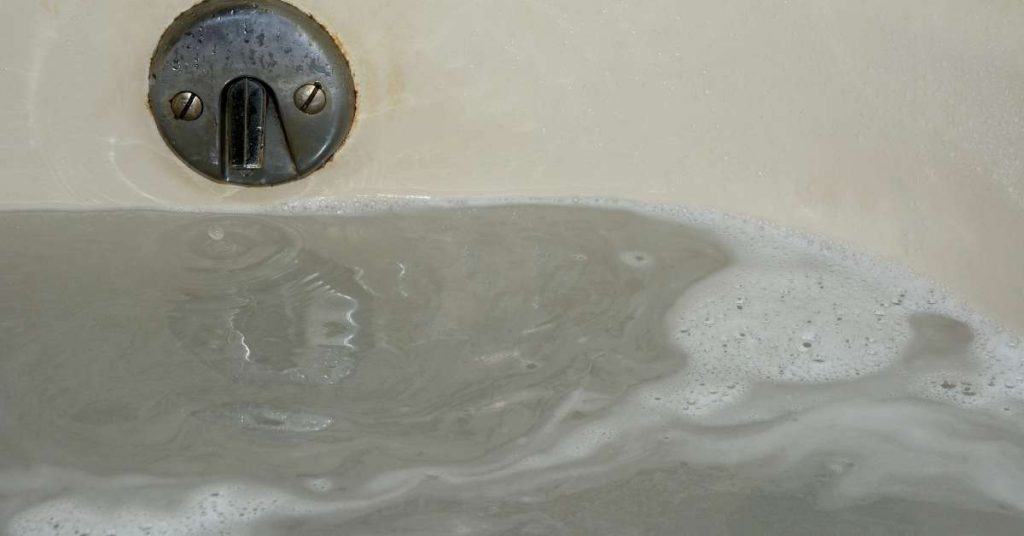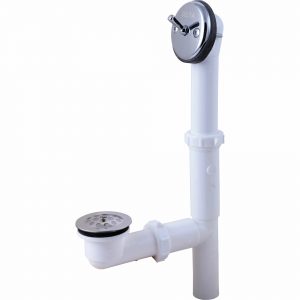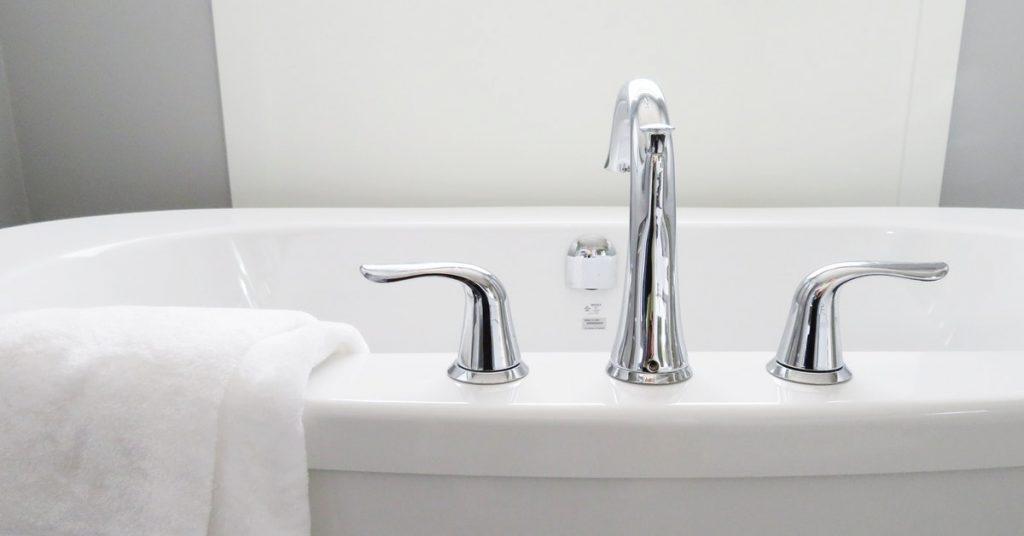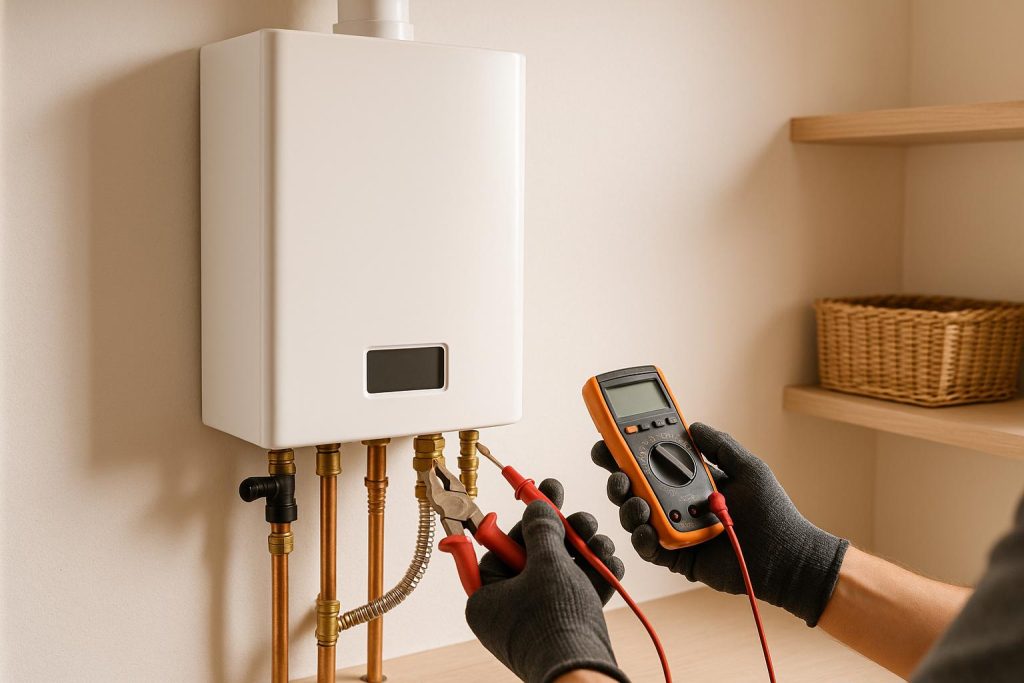There are many types of bathtub drain stoppers but the trip-lever bathtub stopper is the most common. Unlike other types of stoppers, it is usually installed on the overflow drain plate and hence the bottom of the tub is just so smooth.

After years of usage, especially in areas with hard water, the trip-lever tub stopper starts to stick inside the overflow pipe. This problem can either make your bathtub to drain slowly or not hold water when you want to fill it.
A sticky trip-lever bathtub stopper is caused by gunk, hair, soap scum and mineral deposits in the overflow drain. This affects the up and down movement of the stopper’s plunger making it stick on the overflow pipe. You will notice that your bathtub will have problems draining and/or holding water.
Here is how to fix a sticky trip-lever tub stopper:
- Access the Trip Lever: Remove the overflow plate cover on the bathtub’s wall, typically secured with screws, to access the trip lever and linkage.
- Inspect the Linkage: Check the condition of the linkage, including the lever arm, connecting rod, and spring. If any parts are broken or damaged, they may need replacement.
- Adjust the Linkage: If the linkage is simply sticky or not functioning correctly, you can often fix it by adjusting the length or position of the connecting rod. To adjust, loosen the screw or nut on the connecting rod, move it to the desired position, and then tighten it again.
- Clean and Lubricate: If the linkage is sticking due to grime or corrosion, clean it thoroughly and apply a silicone-based lubricant to ensure smooth operation.
- Test the Stopper: Operate the trip lever to check if the stopper now functions correctly. It should open and close smoothly.
- Reassemble and Secure: Reattach the overflow plate cover securely, making sure it aligns with the trip lever and linkage.
- Test the Stopper Again: Fill the tub with water and operate the trip lever to verify that the stopper seals properly and holds water without leaking.
- Replace Damaged Parts (if needed): If the linkage or any components are severely damaged and cannot be repaired, consider replacing them with compatible parts available at hardware stores.
How Does a Trip-Lever Bathtub Work?
A trip-lever bathtub stopper has 4 parts:
- Toggle lever
- 2 link rods
- The plunger

Of the 4 parts, only the toggle lever is visible. It is the small switch on the overflow drain plate. You usually flip it up to close the bathtub drain and down to open it.
Inside the overflow drain, 2 link rods are connected to the plunger. The upper rod is usually threaded. The reason for this is to adjust the total length of the assembly, to fit bathtubs of different heights.
When you flip the toggle lever up, the plunger drops down and sits at the junction where the overflow drain meets the bathtub drainpipe. At that point, the plunger restricts water from flowing down the drain and the tub is ready to fill with water.

When you flip the toggle lever down, the link rods lift off the plunger from the junction and hence opening the drain. At that point the bathtub will start to drain.
In case you are not aware, the overflow drain is the bathtub’s failsafe. When the level of water in the bathtub reaches it, the excess water flows via it down the drain. This prevents the bathtub from overflowing and thus flooding the bathroom.
If your trip-lever tub stopper is getting stuck somewhere in the overflow drain, it also means that your overflow drain integrity is compromised. It is therefore best to fix it as soon as possible.
What Causes the Problem?
The number one cause for sticky trip-lever bathtub stoppers is hard water. Folks who live in areas with hard water will experience this problem. Apart from a sticky trip-lever stopper, you might also have hard water stains in your bathtub, toilets and sinks.
The 2 most notorious minerals are calcium and iron. This mineral deposits are embedded on the stopper plunger making it bigger relative to the internal diameter of the of the overflow drain. As a result, the free up and down movement of the plunger is restricted, making it stick on the inner walls of the overflow.
As you take a bath, strands of hair are washed down the bathtub drain. While most of them wash away, some of them are trapped inside the drain and are picked up by the stopper. Continued accumulation of this hairs will without a doubt make the stopper sticky.
Soap scum and other debris will also contribute to this problem. Just like the case with hair, the scum takes time to build up and you will notice that the stopper does not become sticky at once. It starts off as a minor issue and deteriorates with time.
How to Fix It
Fortunately, fixing a sticky bathtub stopper is very easy. You will however need a few materials upfront. These are:
- Screwdriver
- Emery cloth/sand paper
- Dish soap
- WD-40 (optional)
- New bathtub stopper (optional)
- Grease
- Funnel
Once you have gathered your supplies, it is time to get down to work. Follow these steps to fix a sticky trip-lever bathtub stopper:
1. Remove the Stopper
- Locate the overflow drain on the side of the tub where the toggle lever is.
- On the plate, you will see 2 screws joining the plate to the tub. Use the screwdriver to remove the screws.
- Once the screws are out, hold the plate and lever and try to pull the whole assembly out slowly, ideally upwards and then outwards. Don’t force it out.
- If you find that the assembly is stuck spray some WD-40 inside the overflow drain and wait for 15 minutes.
- After that pulling out the assembly should be easy.
2. Inspect and Clean the Plunger
- Once the trip-lever stopper assembly is out, pour a generous amount of dish soap down the overflow tube. Alternatively you can use other drain cleaners that you have in the house. Give it time to work as you focus on the stopper.
- Keenly inspect the surface of the trip-lever stopper plunger. Can you see rust or calcium mineral deposit all over it?
- Grab an emery cloth/sand paper and scrub off all the minerals deposits from the plunger.
- Apply a decent amount of grease on the plunger to lubricate it.
- Insert a funnel in the overflow opening and blast hot water down the overflow pipe. The hot water combined with the dish soap will dissolve and wash down any type of gunk trapped inside the pipe.
If you notice that the bathtub stopper is in pretty bad shape, you can opt to buy a new bathtub stopper. A new bathtub stopper will serve you well for the next 15 years or thereabout. This one here from Amazon is a decent one.
3. Install the Bathtub Stopper
- Lift the whole stopper assembly in your hand and make sure that it is all clean and straight. Often the 2 link rods get entangled shortening the overall length of the assembly. In that case you will find that the stopper is not travelling the full length as it should and your bathtub will not hold water.
- Put the assembly back down the overflow opening, again being careful not to have the 2 rods entangled.
- Insert the cover plate and the 2 screws back in place and tighten them with the screwdriver.
Try to flip the toggle lever up and down. I am sure you will find it so easy this time round. And that is how to fix a sticky trip-lever bathtub stopper.
How to Remove a Broken Bathtub Drain Stopper
Sometimes the plunger breaks off from the link mechanism and falls at the bottom of the overflow drain. In that case, you will notice that your bathtub cannot drain.
Here is how to quickly remove a broken trip-lever bathtub stopper plunger:
- Start by unscrewing the overflow drain plate.
- Pull out the assembly so that only the plunger is left lying at the bottom of the overflow.
- Grab a wire coat hanger from the closet and straighten it with a pair of pliers.
- Bend it so that it can go down the overflow drain freely.
- Next make a small hook on one end the wire.
- Push the wire down the overflow drain and attempt to hook and fish out the plunger. It can take a while to grab it. Some people are lucky enough to hook it up the first time
- If you don’t have a coat hanger or if you want some flexibility, use a shoe lace and a bent paper clip.






